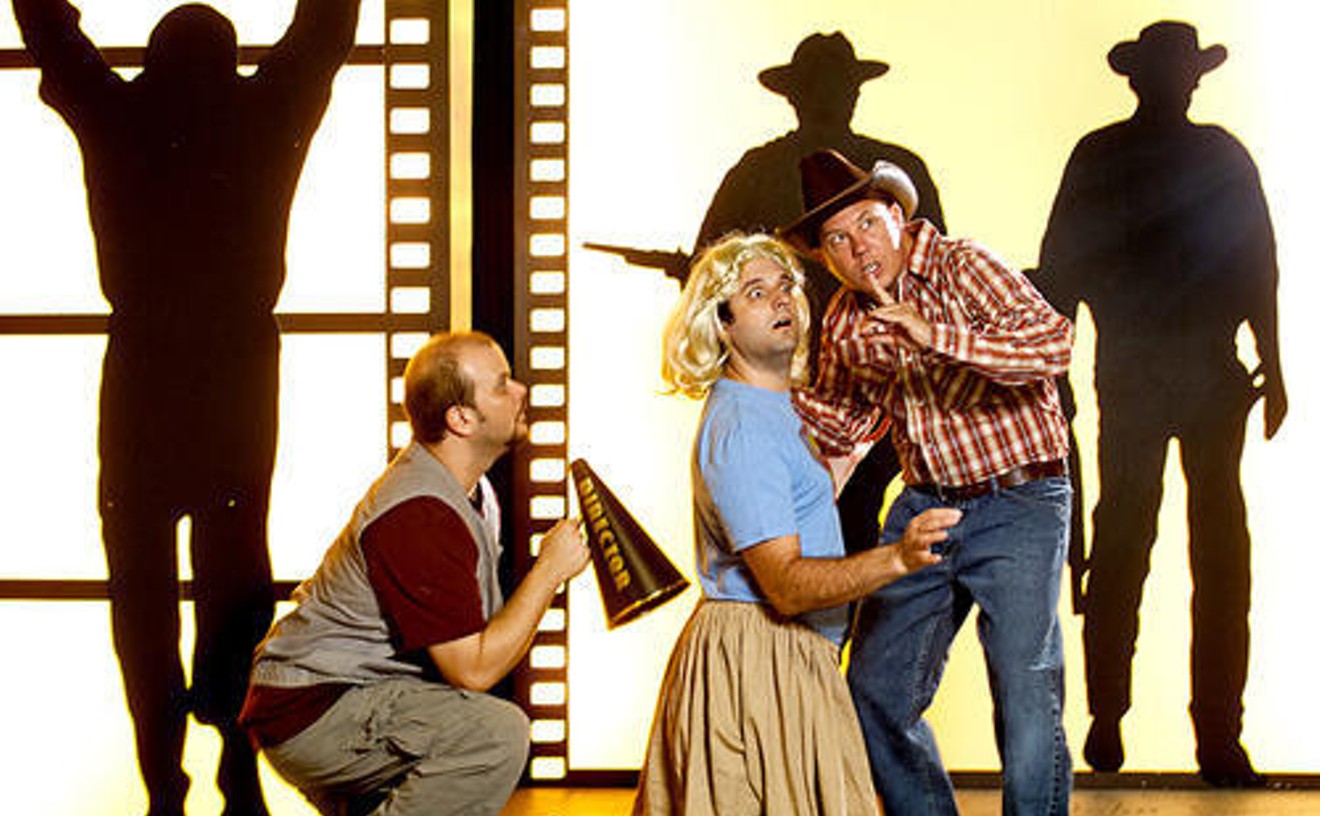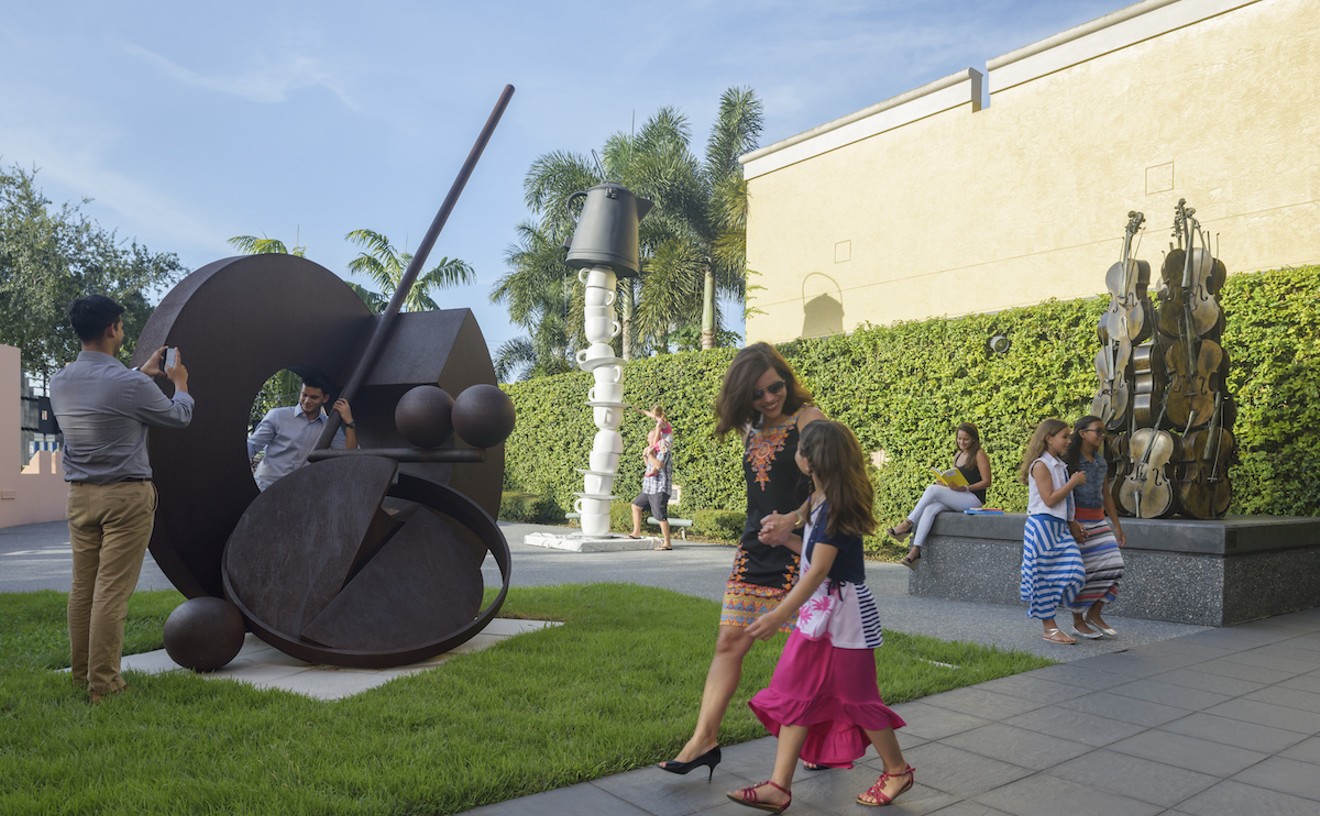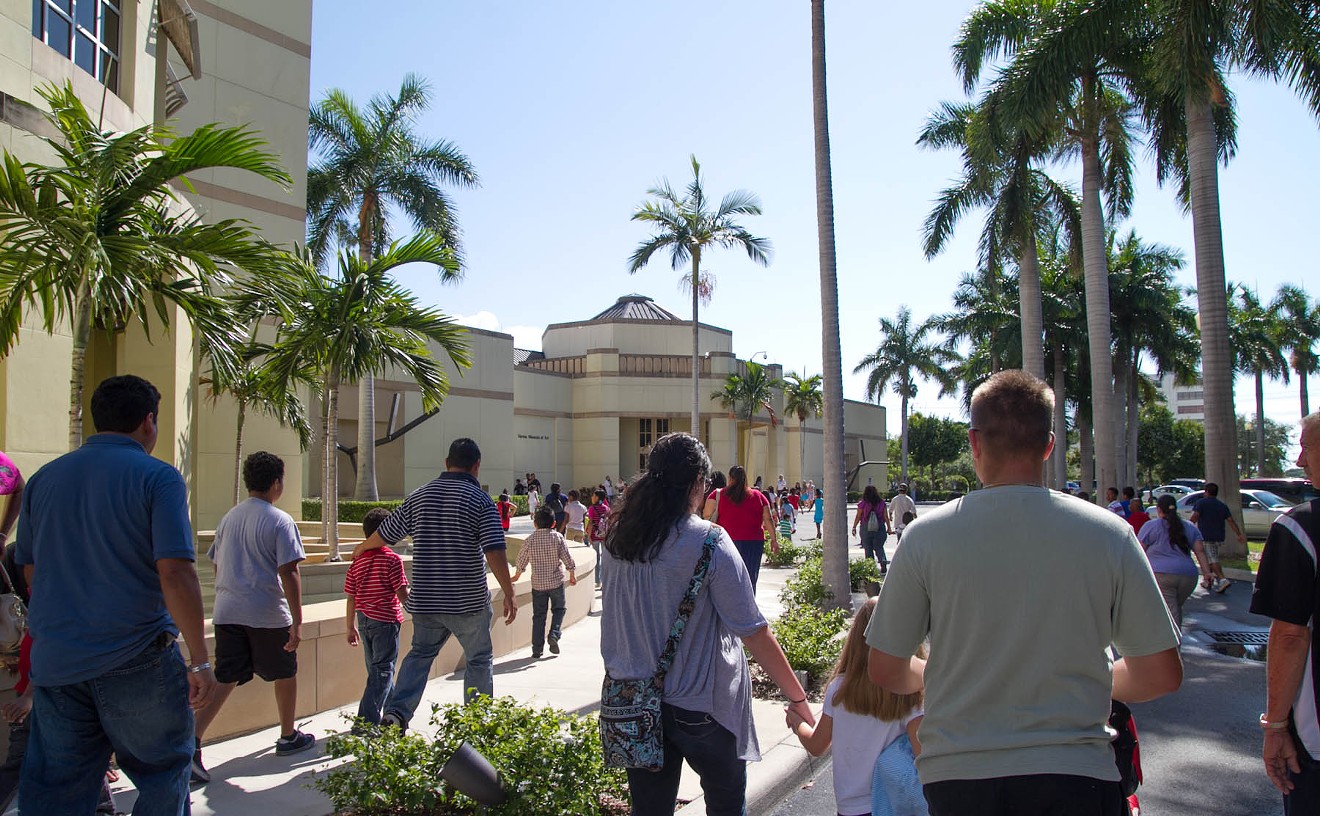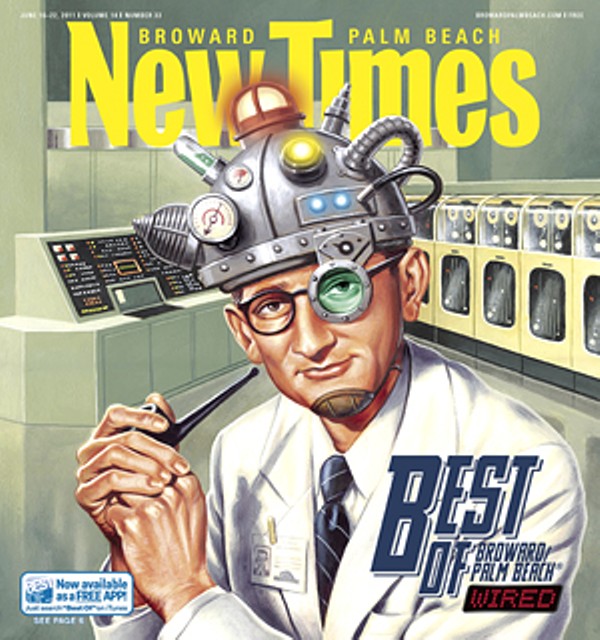The Mosaic Theatre turned 10 this past season, and what a birthday celebration it's been. In early 2010, the theater suffered a rare misfire in the form of the musical Make Me a Song: The Music of William Finn. Since then, it has been one winner after another, like Dying City, the South African diamond-diving drama Groundswell, the energetic and absurdist hilarity of Completely Hollywood, the witty and moving award contender Collected Stories, and the uproarious ensemble piece The Irish Curse. The latter broke attendance records for the theater and prompted the playwright, Martin Casella, to book a flight down here to see it. With Dusk Rings a Bell, the latest from The Laramie Project's Stephen Belber, and Sam Shepard's newest work Ages of the Moon this summer, Broward County's most provocative theater shows no signs of resting.
Best Theater Season
Mosaic Theatre
Best Theatrical Production
Dying City

When Christopher Shinn's Dying City — a difficult and sobering triangle among the widow of an Iraq War veteran, the dead soldier himself, and the soldier's identical twin brother — debuted at Mosaic Theatre last spring, audiences and critics were divided over the source material. It wasn't exactly a fun, joyous night at the theater, and some found the material heavy-handed. But there was something of a consensus when it came to the production itself, which artistic director Richard Jay Simon handled with tenderness, sensitivity, and palm-sweating intensity. Erin Joy Schmidt and Ricky Waugh both spelunked their characters to previously unseen dramatic depths, and Mosaic's technical team created authentic ambiance all around the elegant set.
- 12200 W. Broward Blvd., Plantation, 33325 Map
- 954-577-8243
- www.mosaictheatre.com
Best Musical
Motherhood: The Musical

That Motherhood: The Musical actually stood out as the best musical in Broward or Palm Beach counties over the past 12 months is a genuine shocker. On paper, it's hardly impressive; it's produced by the same team that gave us Menopause: The Musical, and the play's references are as dated as the jokes are corny. But the production was Broadway-ready, with top-shelf lighting, sound design, and props presented with effortless aplomb. The songs were belted out with such gusto by the outstanding four-piece "momsemble" that you could overlook the fact that they were about Costco and "leaking."
- 3301 College Ave., Davie, 33314 Map
- 954-262-4600
Best Set Design
Collected Stories

Here was a set that said a lot by saying very little. Mosaic is best-known for its sprawling set designs, like the ones for Dead Man's Cell Phone and Why Torture Is Wrong, and the People Who Love Them. These are tours de force of horizontal continuity that stretch across multiple locations. In its compact confinement, Collected Stories couldn't be more opposite. The majority of the work takes place in a cramped Greenwich Village apartment beginning in the 1980s. Douglas Grinn evokes this setting with loving accuracy, down to such quotidian details as the type of magazines that would rest atop the coffee table and the squeaky, perpetually jammed windows, to which anyone who has ever lived in the Village — which no doubt includes many South Florida theatergoers — can relate. You could practically reach out and feel the dust clinging to the letter-bound tomes stuffing the living room's bookshelves. All of this combined to exude a romantic feeling, appropriate for a play set in what was, for writers both aspiring and established, very much a romantic place at a romantic time.
- 12200 W. Broward Blvd., Plantation, 33325 Map
- 954-577-8243
- www.mosaictheatre.com
Best Duo Art Exhibition
"Inspired by Nature: Beyond Function"

It's rare to find two artists whose styles are as in tune as Jan Kolenda and Bob Bagley's, and it's rarer still to run across a museum show that plays them off each other as well as this joint exhibition at the Coral Springs Museum. Kolenda works with clay. Bagley is a woodworker. Each had segments of the exhibition devoted to his or her own work, along with a handful of pieces the two artists collaborated on. The marvel, though, is that the works mingled as freely as if they had sprung from the same sensibility — one that prizes the organic over the inorganic, form over function, beauty over practicality.
- 2855 Coral Springs Dr., Coral Springs, 33065 Map
- 954-340-5000
- www.csmart.org
Best Solo Art Exhibition
"Elvis at 21: Photographs by Alfred Wertheimer"

Photography is all about capturing the moment, and no show this year captured its cultural moment as well as this collection of photographs from 1956. That's when a beautiful young man named Elvis Presley was just two years into his soon-to-be tumultuous career and poised to change American pop forever. Alfred Wertheimer was a young photographer-for-hire who had never even heard of Elvis when he spent two brief periods with the singer. But the lensman's instincts were such that his hungry eye was able to catch images that resonate to this day. The exhibition was full of privileged moments filtered through a photographer who knew he was onto something, such as the justly famous image of the singer kissing a young woman he had just met in a hotel diner. The show let us bask in the idea of Elvis as an avatar of potential — Elvis caught in the process of becoming himself.
- 501 Plaza Real, Boca Raton, 33432 Map
- 561-392-2500
- www.bocamuseum.org
Best Photography Exhibition
"Avedon Fashion 1944-2000"

The best photographers succeed at freezing highly specific instants — arresting the flow of time and isolating fragments that refine and define it. Richard Avedon, who was one of the best of the best, defined whole eras of our visual culture through his camera lens. This retrospective at the Norton included more than 150 photographs he took for Harper's Bazaar, Vogue, and the New Yorker (where he was, amazingly, the first staff photographer). The focus may be fashion, but the exhibition and its hefty catalog handily transcend that rarefied world to preserve glimpses of crystallized history. Starting on location in the 1950s and later moving into the studio environment, Avedon rightly realized that fashion isn't just about the clothes; it's about the personalities that inhabit them, and over the course of decades, he mastered the art of distilling personality to its ineffable essence.
- 1451 S. Olive Ave., West Palm Beach, 33401 Map
- 561-832-5196
- www.norton.org
Best Festival
Stitch Rock

It could be said that we have two seasons in Florida — Hurricane Season and Not Hurricane Season. But that would be leaving out an important time of year: Festival Season. Our great festivals include the likes of SunFest, Beerfest, and Garlic Fest, but the art festivals have never been highlights. Stitch Rock set out to change that. With crafts that would give Grandma fits — made by tattooed grrls who would give her nightmares — Stitch Rock provides a venue for the next generation of crafters. Indie shoppers form a line around the Old School Square in Delray Beach hoping to get a free door prize. For the unlucky ones, the vintage goods, upcycled crafts, and gourmet cupcakes make everything OK again. And although it may be only 4 years old, Stitch Rock is already a Festival Season fixture, with the fifth installment already scheduled for October 1.
- 51 N. Swinton Ave., Delray Beach, 33444 Map
- 561-243-7922
- www.oldschool.org
Best Painting Exhibition
"Reclaimed: Paintings From the Collection of Jacques Goudstikker"

History joined forces with art to make this show at the Norton more than just a bunch of paintings. The 40 works included were part of the enormous collection of Jacques Goudstikker, a prosperous Dutch dealer whose inventory was confiscated during World War II by Nazis under second-in-command Hermann Göring. Among Goudstikker's specialties were works from the Italian Renaissance, early Dutch and German paintings, Dutch and Flemish paintings from the 17th Century, French and Italian rococo works, and 19th-century northern European paintings. It took more than half a century for a fraction of the looted art to be returned to the dealer's estate, and fortunately works by such masters as Peter Paul Rubens and Jacob van Ruisdael survived to become part of Goudstikker's Hollywood-worthy adventure story.
- 1451 S. Olive Ave., West Palm Beach, 33401 Map
- 561-832-5196
- www.norton.org
Best Art Museum
Boca Raton Museum of Art

A great museum must perform a delicate balancing act of satisfying the public while also expanding and enhancing that same public's cultural literacy. The Boca Museum has long done an exceptionally fine job of giving the public both what it wants and what it doesn't even know it needs. That has especially been true under the leadership of Executive Director George S. Bolge, who is leaving this summer after roughly 16 years at the museum. During his tenure, Bolge has programmed his share of crowd pleasers, including artists as disparate as Picasso, Duane Hanson, and Purvis Young. But he has invariably emphasized less-familiar artists as well. In the past year alone, he has paired an exhibition of Alfred Wertheimer's photographs of Elvis Presley at 21 with a retrospective of relatively obscure American painter Stanley Boxer; coupled a blockbuster M.C. Escher show with a much smaller one focusing on impressionist Mary Cassatt's works on paper; and juxtaposed Italian artist Valerio Adami with well-known American photorealist painter Robert Cottingham. Most recently, he coupled a flashy "CUT! Costume and the Cinema" show with a horizon-expanding look at California impressionism. Let's hope the museum carries on the great tradition he established.
- 501 Plaza Real, Boca Raton, 33432 Map
- 561-392-2500
- www.bocamuseum.org





